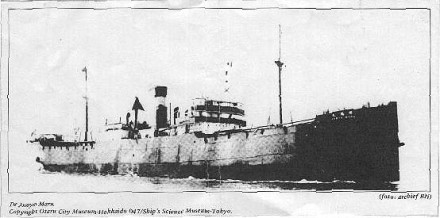History
The Junyo Maru was a transport for prisoners of war during World War II: 1377 Dutch, 64 British and Australian and eight US besides 4200 forced workers from Java. On Monday 18 September 1944, at about 05:30 in the morning, there was a large explosion in the bow of the ship. Moments later another explosion hit the stern. Soon it was realized the ship had been torpedoed by the British submarine HMS Tradewind.
There was little panic in the beginning; none when the engines were turned off, nor when the steam from the boilers was released, nor when the sirens were turned on. But when the stern started to sink and the bow lifted high out of the water panic did set in.
Survival for those that made the water, and many did not, consisted of staying afloat as long as possible by hanging on to a life raft or any other floating material that was around. The Japanese had commanded the lifeboats. The escorts were seen picking up people but seemed to favour the Japanese. However, they continued to pick up survivors and ferry them to Padang some 6 hours away up the coast till late in the night.
The sinking of the Junyo Maru was one of the world's greatest sea disasters – leaving 5620 dead. The 723 survivors who were rescued were put to work in conditions similar to those of the Burma Railway. The list of casualties contains the names of 1382 Dutch, eight US and 56 British and three Australian POWs, but not those of about 4000 Javanese enslaved labourers who also perished. About a hundred Dutch survived the sinking of the Junyo Maru, and ten of these died on the railway.
Description
The Junyo Maru was a freighter built in 1913 in Glasgow. She was fitted with extra decks constructed of bamboo subdivided into cages of the same material.

| Length | 403 ½ feet (123 m) |
|---|---|
| Width | 26 ¼ feet (8 m) |
| Beam | 52 ½ feet (16 m) |
| Displacement | 5065 ton |